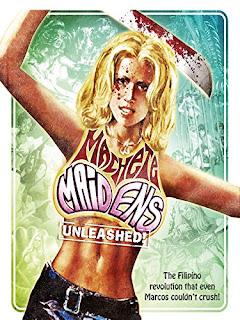
“Since World War II, the Philippines was home to one of the world’s most prolific film industries, producing up to 350 titles a year.
Not one of these films received a theatrical release overseas.
In the late 1960s, this all changed.
Maverick American producers – wanting to create cheap and edgy genre fare outside of the United States – unleashed a tidal wave of productions from the Philippines into drive-in theaters the world over”.
And with the above text scroll, writer / director Mark Hartley, who previously tackled Ozploitation (Not Quite Hollywood) and would eventually set his sights on the craziness that was Cannon Films (Electric Boogaloo), kicks off 2010’s Machete Maidens Unleashed, his venture into low-budget filmmaking in the Philippines, an era that stretched from the late 1960s to the mid-80s.
Featuring archival footage, plenty of interviews, and stories so batshit they will make your head spin, Machete Maidens Unleashed takes us back to the beginning, when American producers tapped Filipino filmmakers Gerardo de Leon and Eddie Romero to turn out a number of low-budget horror movies. The resulting films, known as the Blood Island movies (Brides of Blood, Mad Doctor of Blood Island and Beast of Blood), were financed and released in the U.S. by Hemisphere Pictures. The main star of these movies was American John Ashley, who accepted the roles as a way of getting over his recent divorce. Ashley fell in love with the Philippines, and would remain there for years.
It was Ashley who tipped off his old pal Roger Corman, who was so intrigued by the stories of cheap local labor that he sent director Jack Hill and a film crew over, resulting in the women-in-prison movie The Big Doll House. It was a huge smash, and led to a string of other exploitation films that featured all the blood and nudity that kept drive-in patrons of the day happy.
Corman would eventually hire local Filipino directors to helm these movies, chief among them Cirio Santiago (Fly Me, TNT Jackson). The benefits of making movies with government assistance (martial law was declared by dictator Ferdinand Marcos in 1972, and he was only too happy to assist his American friends by lending out military troops and equipment for their movies) would even Francis Ford Coppola to fly to the Philippines, where, after years of turmoil and hardship, he would turn out one of the greatest movies ever made: Apocalypse Now.
Many of those interviewed for Machete Maidens Unleashed, including directors Eddie Romero, Jack Hill and Brian Trenchard-Smith as well as actors Sid Haig, Pam Grier, Gloria Hendry and Margaret Markov, had first-hand experience of the insanity that was shooting a movie in the Philippine jungles. In the early days, many of the locals carried guns (Jack Hill claims that he and several of his crew saw a man shot to death in a hotel lobby), and relied on local “talent” for everything, even pyrotechnics! From the excessive heat to the large bugs and rodents (Sid Haig claims he watched a rat carry off a kitten), not to mention a lack of any sort of safety protocol (several local stuntmen were killed over the years), it was, as Trenchard-Smith called it, the “Wild East” of low-budget filmmaking.
Many actresses, hoping it would lead to better parts in the future, stripped to their birthday suits and allowed themselves to be put into some dangerous situations. One was tied down naked and, with only a sheet of glass to protect her, found herself face-to-face with a venomous cobra!
Yet, thanks to the low costs associated with these productions, the movies continued to make money. According to Roger Corman, who admitted he “Did not care” for The Big Doll House, it cost $100k to make that picture and it took in over $4 million!
As with Not Quite Hollywood and Electric Boogaloo, Hartley brings an incredible energy to Machete Maidens Unleashed, cutting back-and-forth from interviews to film clips at a pace that makes the documentary, at times, feel like an action film. This, plus additional commentary by the likes of John Landis, Danny Peary, and the duo of Joe Dante and Allan Arkush, who in the ‘70s were tasked by Roger Corman’s New World Pictures to cut trailers for these Filipino movies (Corman admits at one point that the trailers were often better than the movies themselves), Machete Maidens Unleashed is a fascinating glimpse into, as the movie’s subtitle states, The Wild, Untold Story of the Filipino exploitation explosion.
If you’re like me, the minute Machete Maidens Unleashed is over, you’ll be seeking out many of the titles mentioned, if for no other reason than to see if the movies themselves are as crazy as what went on behind the scenes. Of the ones I’ve watched already, I can tell you: they absolutely are!
Rating: 9 out of 10
